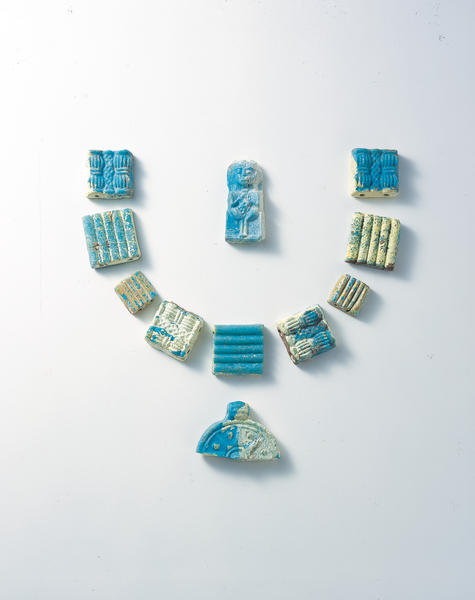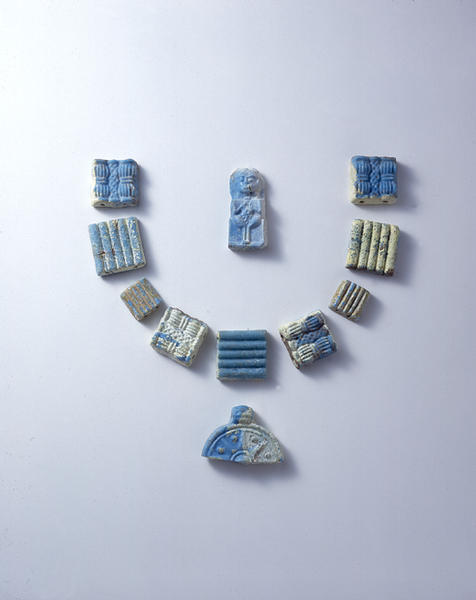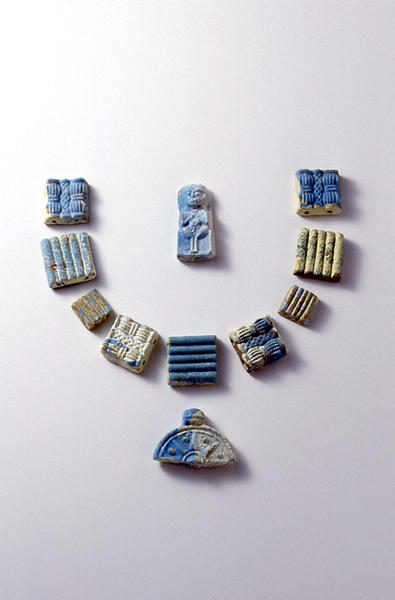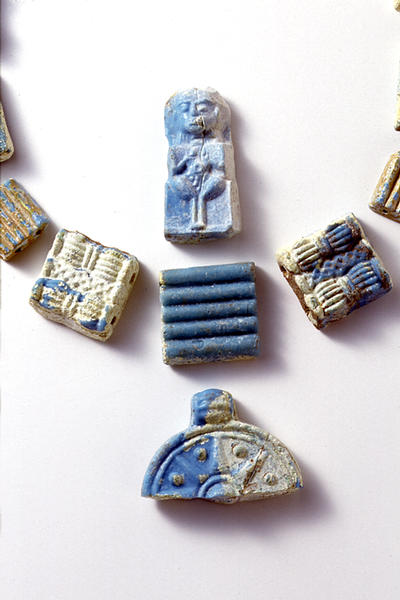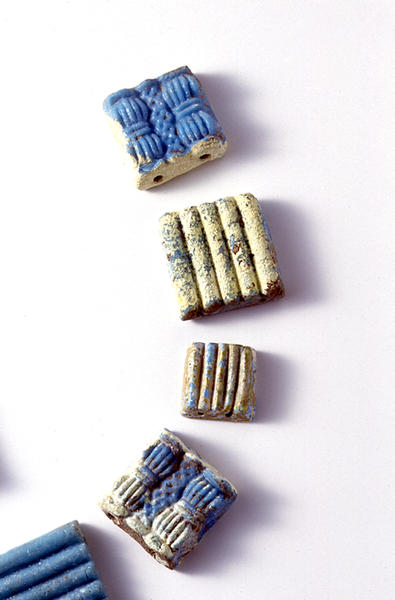ビーズとペンダント
- 北メソポタミア
- 紀元前16世紀後半-紀元前13世紀
- ガラス
- H-4.9 D-1.2 W-2.9
1.(方形ビーズ)解説
上方の開いた開放鋳型に、溶けたガラスを流し込んで作られた方形の水色ガラス製ビーズ。同形だが、2種類の装飾が施されている。1つは上面に5本の平行な畝が表現されたもの。大小2つのタイプがある。他方は、斜格子文の両側に2組の畝文を並べて、3列構成の装飾としたものである。裏面は平ら。いずれも側面に2つの平行な穴が貫通している。つなぎ合わせて幅の広い首飾りとしたのだろう。水色のガラスは、当時非常に珍重されたラピスラズリやトルコ石を模したものと思われる。多くに黄色がかった銀化が見られる。
2.(女性像ペンダント)解説
裸体の女性像を浮き彫りで表現した水色ガラス製のペンダント。開放鋳型で作られ、裏面は平らにならされている。胸に手を当てて、豊かな臀部を強調したこの女性は、メソポタミアの豊穣の女神であるイシュタル(カナーンではアスタルテ)を表したものと考えられている。頭頂部から底部まで縦に穴があけられており、護符として身に付けたのだろう。また、奉納品として使われたと考えられているこの女性像と同じ姿の型押し土偶が、前2千年紀の西アジアに広く分布しており、このガラス製品も同じ用途があったのかもしれない。
3.(星文ペンダント)解説
開放鋳型で作られた水色ガラス製円盤形ペンダントの断片。下半部は失われているが、同心円の中に8稜の星形を表し、稜の間に円点を配したと推定できるモティーフが、浮き彫りで表現されている。中央の円は高く盛り上がる。吊環は幅広く、横畝状の文様が施され、横方向に穴があけられている。裏面は平ら。銀化が見られる。同じような星形の文様をもつ金製のペンダントも、西アジアでは広く知られている。このモティーフはイシュタル女神のシンボルといわれており、図版2の女性像ペンダントと同じように護符として、あるいは奉納品として使われたものと思われる。
ガラス製作は、前3千年紀末にメソポタミアで開始されたと考えられているが、ガラス容器が作られるのは前16世紀後半になってからのことであった。出現期のガラス容器製作にはすでに高度な技術が使われており、当時北メソポタミアを支配していたフリ人のミタンニ王国の文化圏を中心として、多彩な装飾が施された多様な製品が出土している。これら、水色系のガラスで作られた方形ビーズや、女性像、星文あるいは無文の円盤形ペンダントも、最初期のガラス容器と同時代に製作された代表的なガラス製品であり、北メソポタミアを中心として、小アジアやシリア・パレスティナ、さらにミケーネからも出土例が知られている。
Catalogue Entry
Molten glass was poured into an open mold to form these square pale blue glass beads. The same shape of bead was then decorated with two different patterns. Beads with the first decoration pattern have five parallel ribs on the top surface. There are large and small versions of this type. Beads with the other decoration pattern have a diagonally arranged lattice pattern sided by two groups of ribbed lines to form a three-row design. The backs of the beads are flat. Both types of beads have two parallel holes piercing their sides. When strung together they would have formed a wide necklace. This pale blue colored glass is thought to have been created to imitate rare and costly turquoise and lapis lazuli stones. Many of these beads have a yellowish iridescence.
Catalogue Entry
This pale blue glass pendant is decorated with a relief carved image of a nude female. Cast in an open mold, the back of this pendant is smooth and flat. This image of a woman, holding her hands to her chest, emphasizing her abundant hips, is thought to represent the Mesopotamian goddess of fertility, Ishtar (in Canaan this goddess was known as Astarte). A hole extends vertically from the top of the woman's head to the base of the pendant, and the pendant was probably worn as an amulet. Molded clay figurines of the same type of female image which could have been used as an offertory items were widely distributed throughout West Asia during the 2nd millenium BC. This glass work may have had a similar purpose.
Catalogue Entry
This is a fragment of a pale blue glass disk pendant, which was made in an open mold. The lower half has been lost, but originally the pendant would have shown an 8-pointed star centered on the center of the disk. The presumed motif of round spots distributed between the points of the star was expressed in relief form. The center of the circle is highly built up. The hanging ring is wide and has been decorated with a horizontal ribbed motif, and there is a hole which opens from the side. The back is flat. There is irideceence on the surface. Gold pendants with this same type of star motif are widely known throughout West Asia. This motif is thought to be a symbol of the fertility goddess Ishtar. The pendant would have been worn as an amulet in the same manner as female-image pendants, or would have been similarly used as an offering.
The production of glass is thought to have begun at the end of the 3rd millenium BC in Mesopotamia. The first glass vessels were used in the latter half of the 16th century BC and have been excavated from areas within the cultural sphere of the Mitanni kingdom of the Hurrian peoples who ruled northern Mesopotamia during this period. Highly refined techniques were in use by this time period and they were used to create vessels in a variety of shapes, decorated in diverse manners. These pale blue glass square beads, female images, circular disk pendants with either no design or star patterns are representative glass works made during the same period as the earliest glass vessels. Excavated examples of these forms have been found primarily in northern Mesopotamia, and others have been found in Asia Minor, Syria, Palestine and Myceanae.
解説(古代バクトリア遺宝展)
前16世紀後半―前13世紀
ガラス
方形ビーズ:1.9-2.9×1.9-2.9 cm 厚0.8-0.9 cm
女性像ペンダント:高4.9 cm 幅2.4 cm 厚1.1 cm
星文ペンダント:高3.5 cm 径(推定)5.0 cm 厚1.2 cm
本作品のような青いガラスで作られたビーズやペンダントは、紀元前16世紀後半から前二千年紀後半にかけて、北メソポタミア、シリア・パレスチナ地域を生産の中心としたメソポタミア南部、東地中海地域などに広く普及したものである。これらは開放型の鋳型で作られたもので、背面は平坦になっている。特に方形ビーズはミケーネから北西イランまで最も広い分布を示している。裸形の女性を表したペンダントは正面を向き、胸を両手で下から掴み強調する仕草をしている。この意匠は焼物でも多くの例があり、豊穣を意味する象徴であった可能性がある。円形のペンダントは今はその半分が失われているが、中心に半球形の突起をもった八星芒が作り出されている。この天体の意匠は西アジアでイシュタル女神の象徴でおそらく金星を示すものであり、この青い色彩は女神の名が意味する「天の婦人」にふさわしいものだったのであろう。この種のガラスビーズ、ペンダントは主に北メソポタミアのヌジで最も多くの種類が見つかっており、ここから地中海にもたらされた可能性が高いと考えられている。ミケーネではこれらが神殿の奉納物とされた例もある。
Catalogue Entry(Bac#009)
Latter half of the 16th‐13th century B.C.
Glass
Square beads with ribbed pattern: 1.9-2.9×1.9-2.9 cm, Thickness 0.8-0.9 cm
Pendant in the shape of women: H. 4.9 cm, W. 2.4 cm, Thickness 1.1 cm
Star disk pendant: H. 3.5 cm, Dia. (suggested) 5.0 cm, Thickness 1.2 cm
These beads and pendants made of blue glass are of a type widely
distributed from the latter half of the 16th century BC through the latter half of the 2nd millennium BC across southern Mesopotamia and the eastern Mediterranean, with production centered in northern Mesopotamia, Syria and Palestine. These beads were cast in open molds and their backs are flat. The square beads had the largest distribution, ranging from Mycenae through northwestern Iran. The pendant depicting a nude female shows the woman facing forward with both arms clasping her breasts from below in an exaggerated pose. This design can also be found on many pieces of pottery and it could possibly be a symbol of fertility. Half of the round pendant is now missing but it originally had a semi-circular protrusion in the center and would have formed a eight-pointed star. This astronomical design was the symbol of the goddess Istal in western Asia and probably represents Venus. The blue color used here is suitable for this image of the goddess whose name means Lady of Heaven. This type of glass bead and pendant was found in the greatest variety in Nuzi in northern Mesopotamia, and it is highly likely that this bead and pendant time was then distributed from Nuzi throughout the rest of the Mediterranean area. There are examples of these beads as offertory goods at temples in Mycenae.
